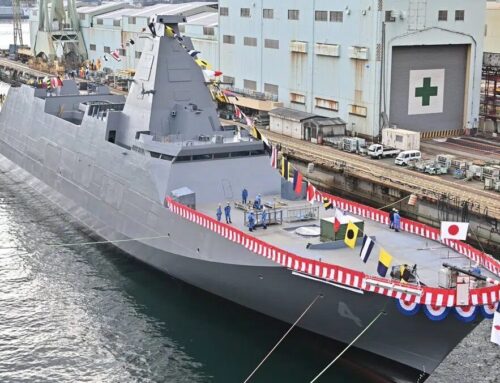Defense Innovation Board member Navy Adm. (retired) Michael Mullen attends a meeting of the board, the Pentagon, Washington, D.C., Oct. 17, 2022. (DoD photo by Lisa Ferdinando)
WASHINGTON — The Pentagon’s Defense Innovation Board is calling for a major restructure of the Defense Department’s acquisition shop, with a new recommendation released Wednesday saying it is time to recreate the old Undersecretary for Acquisition Technology and Logistics (AT&L) office.
As one of two recommendations off of separate studies passed unanimously by the board, the DIB wants to see the offices of the undersecretaries for Acquisition & Sustainment (A&S) and Research and Engineering (R&E) merged back together. The new office will not be called the AT&L, but instead has the working name of the Office of the Under Secretary of Defense for International Integration and Cooperation.
Congress split the AT&L office into the offices of A&S and R&E in the National Defense Authorization Act of 2017, after years of questioning from leaders about whether having such an immense, joint office was logical in fulfilling modern technological needs. (Air Force Secretary Frank Kendall, the last person to hold the title of undersecretary of AT&L, fiercely advocated for not splitting up the office.)
Now, the DIB contends that the division of the office has hindered technological development.
During the meeting Wednesday morning, DIB member Charles Phillips said that the board wants to recombine these offices because the DoD “need[s] integrated designs, we need integrated manufacturing capacity around the world. It’s hard to do that in separate organizations.”
During a Defense Writers Group event held Wednesday evening, Phillips, the head of tech investment firm Recognize and a former president of Oracle, also said the creation of the International Integration and Cooperation office would help DoD to better take advantage of innovation happening in allied nations. He said with the two currently separate offices, it can be perplexing for allies to know how to get involved with partnerships.
“If it’s too fragmented, it’s hard for them [allies] to engage. So having a single organization that [says] ‘Here’s what we’re gonna build, here’s what we’re going to research on, here’s what happens to produce it and here’s how we’re going to distribute the production, here are the jobs that are involved.’ So that has to be there as well. All of that has to be done upfront as a team, so that’s the reason they have it in one place,” Phillips said.
Michael Mullen, the former Chairman of the Joint Chiefs of Staff now on the DIB, added to Phillip’s comments Wednesday evening, saying that the offices need to be combined also for the benefit of start-ups and small businesses. He said with the separate offices, it’s tough for new companies to know who to go to within the Pentagon to sell their technology.
“Now I’m out there as a startup. Where do I start? How do I even get into this system? In my world, which is an old world, you know, where’s the number in the Yellow Pages that I call to get in? It’s an unbelievably difficult building to penetrate,” he said.
It’s important to note that the DIB is an advisory board only, and has no power other than to give its advise to the Secretary of Defense. And even if the SecDef agrees with the recreation of AT&L by another name, the Pentagon would need to turn to Congress — the body that split the office into two just eight years ago — to authorize the move.
But the DIB does have influence, and putting this recommendation out to the public could jump start the conversation, or give cover to those who have been hoping to recreate the single acquisition office model.
Navy Capt. Colin Kane, a guest speaker at the board’s Wednesday morning meeting who also works with the Joint Rapid Acquisition Cell, echoed the board members’ recommendation to reinstate an office similar to AT&L, saying that the department has been unable to “field urgent needs of the counter uncrewed systems threat” because of the lack of communication between the two offices.
“Since we separated OSD A&S from R&E, we aren’t seeing the ability or effective means of communication. Combining those two organizations, there would be a benefit, and I think unity of effort that moves us in a direction that helps us to make those things [uncrewed systems threat] more effective and get industry clearly moving,” Kane said.
“We have got to make sure that we are basically leading the target, and perhaps right now we’re shooting to the left of the target in terms of being able to bring those capabilities and field them faster. There’s not a path that clearly gets those innovations that are being fielded or developed by our FFRDC [federally funded research and development centers] and UARCs [University Affiliated Research Centers] to have that feed into the POM process,” he added.
Accepting Risk
The acquisition reform concept was only one of two recommendations the DIB passed on Wednesday. The board also recommended that DoD needs to be less averse to taking risks and to model the commercial sector’s attitude on taking chances on emerging technology. Otherwise, Mullen said, “China will overtake” the US in regards to technological innovation.
“There are two fundamentally different cultures both inside DoD and certainly out in the commercial sector, particularly on the startup side,” Mullen said Wednesday morning. “The building is very risk averse, and the requirement is to move very, very rapidly, which is going to require a significant increase in the appetite for risk.”
“The conundrum for me has always been we grow up as warfighters in the field, at sea and through wars, taking a lot of risks. It’s oftentimes calculated risks, our lives on on the line, in an environment that requires us to take risks to win. Then we come back […] into the building and we don’t take any risks. That speaks to the, I think, culture that’s there that we all get absorbed into, not taking that risk,” he added at Wednesday evening’s discussion.
In a release after the DIB meeting, the board stated that it will “soon announce two future studies that will support key DoD priorities related to unmanned systems and engagement with nontraditional defense industry.”











